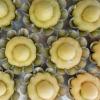
First sourdough loaf, a la Tartine
After tending to my new starter for two weeks, I finally got the courage to make some bread with it. I used the Tartine basic country loaf formula, which yielded two decently sized loaves. The leaven was made at around 10 PM the night before, the dough mixed at 11 AM the following morning, and the first loaf baked at around 7 PM. To my dismay, it came out like a dense, insipid sponge with a huge cavern in the middle. My boyfriend said "don't take this the wrong way, but it kind of tastes like my mom's bread machine boxed sourdough." Just to give a little background, he routinely insults his mother's cooking, so that didn't bolster my confidence much.
The book says that bulk fermentation should take between 3-4 hours at 78-82 degrees, and my kitchen wasn't nearly that warm. I wasn't sure whether it was severely underproofed, or whether my starter wasn't up to snuff, so just for kicks, I left the second batch of dough out overnight at around 60 degrees Fahrenheit.
In the morning, the dough had expanded in volume noticeably and felt pretty well aerated. I shaped it, proofed it for around 3 and a half hours, and baked it at 475 underneath a large preheated stainless steel bowl for 20 minutes, followed by 30 minutes uncovered. Here are the results:
The crust got a little burnt on one side due to uneven oven heat, and I didn't quite get the kind of spring I wanted - the profile was a bit flat. However, I'm pretty happy with the crumb:
I think I would prefer to make it a little more sour next time, perhaps by increasing the proportion of starter in the leaven? Maybe the flavor will come naturally as my starter matures over time. Overall, this bake was a good lesson in adapting to variable temperature conditions, and "listening" to the dough rather than the watching the clock. Around 15 hours passed between the failed loaf and the decent loaf.


Comments
Very nice looking crumb. It is probably simply that your sourdough starter hasn't been around long enough to be strong, and that can definitely affect the flavor also. Your starter will get stronger the longer you have it especially out on the counter feeding it regularly. I recently made a starter and kept it out on the counter feeding it twice and day, then backing off to once a day, and it took over a month to get it to the point where it was active enough to really handle making a loaf of bread by itself. For the first month I simply added a small amount of commercial yeast to the bread I made, making sure not to get any into my mother starter. That just shows my impatience at not wanting to wait extremely long times to get the rise I wanted. Lets see, I started mine in November I think, and my starter is now strong enough that it can handle a week in the fridge and not produce hooch, and it can come out and produce awesome crumb without even feeding first. Sounds like you are right on track for a really awesome starter! Sourdough bread will always be my favorite...
Joanne
Wow, gorgeous glossy cell walls, open crumb. Bakery quality at home.
Lots of things you can do to make it more sour. Starter that is 24 hours old instead of 8. The lactobacilli yeast grow slower than the yeasties. Try adding a bit of rye flour. That'll up the sour flavor too.
I wouldn't be disappointed with the crumb yy. The cell structure looks good from here. Was it very moist? I have found with the Tartine breads hydrated as they are, you need to bake them a little harder than normal.
After looking at the crust a little , I don't think I would call that over done or burned at all. Caramelized is flavorful.
Eric
thanks for the advice, matt and Joanne. Eric, yes the crumb is very moist, so I vented the oven for a larger portion of the bake and also left it inside while the oven was cooling. The procedure wasn't too far off from what I do normally, because I typically do my breads at around 75% hydration or so. After actually taking a bite of the bread, I agree with you - the flavor is caramelized more so than burnt.
Thanks for the feedback!
Great looking crumb!
What do you mean by venting the oven for a large portion of the bake. Is your oven equipped with a fan?
So for this loaf, how long did you ferment it and at what temperature? You said 60 deg overnight but during the day?
Did you place one of those mixing bowls over your bread? Did you mist the proofed loaf or just steamed itself?
Thank you
Cachi